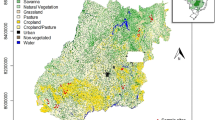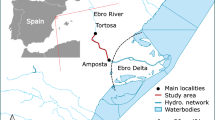Abstract
We examined the introduction history of non-native freshwater fish in Okinawa-jima Island, Japan, to identify the pathway posing the greater risk for future invasions and to measure the strength of ornamental fish introductions as a vector of new invasions using all available records of freshwater fish introductions to date. At least 45 non-native freshwater fish have been introduced to Okinawa-jima Island. Of those, 22 species have successfully established in natural waters and, consequently, non-native fish species represent 76 % of the total freshwater fish fauna. The most important pathway was via the dumping of unwanted ornamental aquarium fish, which accounted for 71 % of the total introductions. The introduction of ornamental fish has occurred extensively in recent decades, and all fish introduced since the 1980s have been ornamental aquarium fish. The overall rate of establishment success was estimated at 51 %, although this is undoubtedly an overestimate because of unreported failed introductions. Establishment rates varied between stocked fish (100 %) and dumped ornamental fish (39 %), which may reflect the low propagule pressure of ornamental fish. From the observed trends in freshwater fish introductions, the dumping of ornamental fish into natural waters is expected to continue if no action is taken to reduce this most important pathway. We recommend regulations against the release of unwanted pet fish into natural waters, better programs for returning unwanted pet fish to stores or local zoos, educational programs for aquarists and retailers, and regulations against selling and trading ornamental fish that are judged to pose a high risk of causing economic or ecological harm.



Similar content being viewed by others
References
Casal CMV, Luna S, Froese R, Bailly N, Atanacio R, Agbayani E (2007) Alien fish species in the Philippines: pathways, biological characteristics, establishment and invasiveness. J Environ Sci Manag 10:1–9
Chang AL, Grossman JD, Spezio TS, Weiskel HW, Blum JC, Burt JW, Muir AA, Piovia-Scott J, Veblen KE, Grosholz ED (2009) Tackling aquatic invasions: risks and opportunities for the aquarium fish industry. Biol Invasions 11:773–785
Copp GH, Bianco PG, Bogutskaya N, Erős T, Falka I, Ferreira, MT, Fox MG, Freyhof J, Gozlan RE, Grabowska J, Kováč V, Moreno-Amich R, Naseka AM, Peňáz M, Povž M, Przybylski M, Robillard M, Russell IC, Stakėnas S, Šumer S, Vila-Gispert A, Wiesner C (2005) To be, or not to be, a non-native freshwater fish? J Appl Ichthyol 21:242–262
Copp GH, Templeton M, Gozlan RE (2007) Propagule pressure and the invasion risks of non-native freshwater fishes: a case study in England. J Fish Biol 71:148–159
Copp GH, Vilizzi L, Mumford J, Fenwick GV, Godard MJ, Gozlan RE (2009) Calibration of FISK, an invasiveness screening tool for non-native freshwater fishes. Risk Anal 29:457–467
Corfield J, Diggles B, Jubb C, McDowall RM, Moore A, Richards A, Rowe DK (2007) Draft final report for the project ‘Review of the impacts of introduced aquarium fish species that have established wild populations in Australia’. Prepared for the Australian Government Department of the Environment and Water Resources. http://www.environment.gov.au/biodiversity/invasive/publications/pubs/wild-aquarium-fish.pdf. Accessed 7 August 2013
Deacon AE, Ramnarine IW, Magurran AE (2011) How reproductive ecology contributes to the spread of a globally invasive fish. PLoS ONE 6(9) doi:10.1371/journal.pone.0024416
Duggan IC (2010) The freshwater aquarium trade as a vector for incidental invertebrate fauna. Biol Invasions 12:3757–3770
Duggan IC, Rixon CAM, MacIsaac HJ (2006) Popularity and propagule pressure: determinants of introduction and establishment of aquarium fish. Biol Invasions 8:393–398
Froese R, Pauly D (2011) FishBase. http://www.fishbase.org. Accessed 8 November 2011
García-Berthou E, Alcaraz C, Pou-Rovira Q, Zamora L, Coenders G, Feo C (2005) Introduction pathways and establishment rates of invasive aquatic species in Europe. Can J Fish Aquat Sci 62:453–463
Gertzen E, Familiar O, Leung B (2008) Quantifying invasion pathways: fish introductions from the aquarium trade. Can J Fish Aquat Sci 65:1265–1273
Gozlan RE (2008) Introduction of non-native freshwater fish: is it all bad? Fish Fish 9: 06–115
Gozlan RE (2009) [Response by Gozlan R] Biodiversity crisis and the introduction of non-native fish: solutions, not scapegoats. Fish Fish 10:109–110
Gozlan RE, Britton JR, Cowx I, Copp GH (2010) Current knowledge on non-native freshwater fish introductions. J Fish Biol 76:751–786
Hulme PE, Bacher S, Kenis M, Klotz S, Kühn I, Minchin D, Nentwig W, Olenin S, Panov V, Pergl J, Pyšek P, Roques A, Sol D, Solarz W, Vilà M (2008) Grasping at the routes of biological invasions: a framework for integrating pathways into policy. J Appl Ecol 45:403–414
Ishikawa T, Tachihara K (2012) Reproductive biology, growth, and age composition of non-native Indian glassy fish Parambassis ranga (Hamilton, 1822) in Haebaru Reservoir, Okinawa-jima Island, southern Japan. J Appl Ichthyol 28:231–237
Ishikawa T, Takada M, Tokunaga K, Tachihara K (2013) Current status and distribution patterns of non-native freshwater fish on Okinawa-jima Island. Jpn J Conserv Ecol 18:5–18
Jeschke J, Strayer DL (2005) Invasion success of vertebrates in Europe and North America. Proc Natl Acad Sci U S A 102:7198–7202
Kochi R (1991) The introduced fresh water animals in Okinawa Island. In: S. Ikehara (ed) Surveys on impacts of introduced animals on native species in Nansei Islands. Nature Preservation Bureau, Japan Environmental Agency, Tokyo, pp 55–97
Kolar CS and Lodge DM (2002) Ecological predictions and risk assessment for alien fishes in North America. Science 298:1233–1236
Leprieur F, Brosse S, García-Berthou E, Oberdorff T, Olden JD, Townsend CR (2009) Scientific uncertainty and the assessment of risks posed by non-native freshwater fishes. Fish Fish 10:88–97
Marchetti MP, Moyle PB, Levine R (2004) Invasive species profiling? Exploring the characteristics of non-native fishes across invasion stages in California. Freshw Biol 49:646–661
Matsumoto S, Kon T, Yamaguchi M, Takeshima H, Yamazaki Y, Mukai T, Kuriiwa K, Kohda M, Nishida M (2010) Cryptic diversification of the swamp eel Monopterus albus in East and Southeast Asia, with special reference to the Ryukyuan populations. Ichthyol Res 57:71–77
Morgan DL, Gill HS, Maddern MG, Beaty SJ (2004) Distribution and impacts of introduced freshwater fishes in Western Australia. N Z J Mar Freshwater Res 38:511–523
Ng HH, Tan HH (2010) An annotated checklist of the non-native freshwater fish species in the reservoirs of Singapore. Cosmos 6:95–116
Nishida M, Shikatani N, Shokita S (2003) The flora and fauna of inland waters in the Ryukyu Islands. Tokai University Press, Tokyo
Onikura N, Nakajima J, Inui R, Mizutani H, Kobayakawa M, Fukuda S, Mukai T (2011) Evaluating the potential for invasion by alien freshwater fishes in northern Kyushu Island, Japan, using the Fish Invasiveness Scoring Kit. Ichthyol Res 58:382–387
Padilla DK, Williams SL (2004) Beyond ballast water: aquarium and ornamental trades as sources of invasive species in aquatic ecosystems. Front Ecol Environ 2:131–138
Pyšek P, Jarošík V, Hulme PE, Kühn I, Wild J, Arianoutsou M, Bacher S, Chiron F, Didžiulis V, Essl F, Genovesi P, Gherardi F, Hejda M, Kark S, Lambdon PW, Desprez-Loustau M-L, Nentwig W, Pergl J, Poboljšaj K, Rabitsch W, Roques A, Roy DB, Shirley S, Solarz W, Vila M, Winter M (2010) Disentangling the role of environmental and human pressures on biological invasions across Europe. Proc Natl Acad Sci USA 107:12157–12162
Rabitsch W, Milasowszky N, Nehring S, Wiesner C, Wolter C, Essl F (2013) The times are changing: temporal shifts in patterns of fish invasions in central European fresh waters. J Fish Biol 82:17–33
Ribeiro F, Elvira B, Collares-Pereira MJ, Moyle PB (2008) Life-history traits of non-native fishes in Iberian watersheds across several invasion stages: a first approach. Biol Invasions 10:89–102
Ribeiro F, Collares-Pereira MJ, Moyle PB (2009) Non-native fish in the fresh waters of Portugal, Azores and Madeira Islands: a growing threat to aquatic biodiversity. Fish Manag Ecol 16:255–264
Rixon CAM, Duggan IC, Bergeron NMN et al (2005) Invasion risks posed by the aquarium trade and live fish markets on the Laurentian Great Lakes. Biodivers Conserv 14:1365–1381
Roll U, Dayan T, Simberloff D, Goren M (2007) Characteristics of the introduced fish fauna of Israel. Biol Invasions 9:813–824
Ruesink JL (2005) Global analysis of factors affecting the outcome of freshwater fish introductions. Conserv Biol 19:1883–1893
Severinghaus L, Chi L (1999) Prayer animal release in Taiwan. Biol Conserv 89:301–04
Shafland PL, Gestring KB, Stanford MS (2008) Florida’s exotic freshwater fishes—2007. Florida Sci 71: 220–245
Shokita S (1984) Naturalized animals. In: Okinawan animals. Japan Association of Biology Education Okinawa Convention, pp 377–384
Strecker AL, Campbell PM, Olden JD (2011) The aquarium trade as an invasion pathway in the Pacific Northwest. Fisheries 36:74–85
Tachihara K (2005) Endangered fishes of the Ryukyu Archipelago. In: Katano O, Mori S (eds) Present and future of endangered freshwater fishes in Japan—Scenarios for active conservation. Shinzan-Sha, Tokyo. pp 297–310
Tachihara K, Tokunaga K, Chimura Y. (2002) Non-native fishes in Okinawa Island. In: Ecological Society of Japan (eds). Handbook of non-native species in Japan. Chijin-shokan, Tokyo, pp 248–249
Takada M, Tachihara K, Kon T, Yamamoto G, Iguchi K, Miya M, Nishida M (2010a) Biogeography and evolution of the Carassius auratus-complex in East Asia. BMC Evol Biol 10:7 doi:10.1186/1471-2148-10-7
Takada M, Tachihara K, Nishida M (2010b) Distribution and habitats of Carassius auratus in the Ryukyu Archipelago: comparisons between indigenous and introduced populations. Jpn J Ichthyol 57:113–123
Thomas VG, Vasarhelyi C, Niimi AJ (2009) Legislation and capacity for rapid-response management of nonindigenous species of fish in contiguous waters of Canada and the USA. Aquat Conserv 19:354–364
Tricarico E (2012) A review on pathways and drivers of use regarding non-native freshwater fish introductions in the Mediterranean region. Fish Manag Ecol 19:133–141
Vitule JRS, Freire CA, Simberloff D (2009) Introduction of non-native freshwater fish can certainly be bad. Fish Fish 10:98–108
Webb AC (2007) Status of non-native freshwater fishes in tropical northern Queensland, including establishment success, rates of spread, range and introduction pathways. J Proc R Soc NSW 140: 63–78
Williamson M (1996) Biological Invasions. Chapman and Hall, London
Yamamoto MN, Tagawa AW. (2000) Hawaii’s native & exotic freshwater animals. Mutual Publishing. Honolulu
Yamazaki M (2012) Tamazon gawa—Tamagawa de inochi wo kangaeru. Junposha, Tokyo
Yoshigou H, Iwasaki M (2001) The invasive species of fishes in Okinawa-jima Island, Ryukyu Islands, Japan. Hibakagaku 201:15–26
Acknowledgments
Our thanks are extended to Y. Sawashi (Ministry of the Environment, Japan) for providing detailed information on Lepisosteus oculatus. This study was supported by a grant from the Japanese Fisheries Agency, a Grant-in-Aid from the Ministry of Education, Culture, Sports, Science and Technology, Japan (No. 15580169), and the 21st Century COE program of the University of the Ryukyus.
Author information
Authors and Affiliations
Corresponding author
About this article
Cite this article
Ishikawa, T., Tachihara, K. Introduction history of non-native freshwater fish in Okinawa-jima Island: ornamental aquarium fish pose the greatest risk for future invasions. Ichthyol Res 61, 17–26 (2014). https://doi.org/10.1007/s10228-013-0367-6
Received:
Revised:
Accepted:
Published:
Issue Date:
DOI: https://doi.org/10.1007/s10228-013-0367-6




